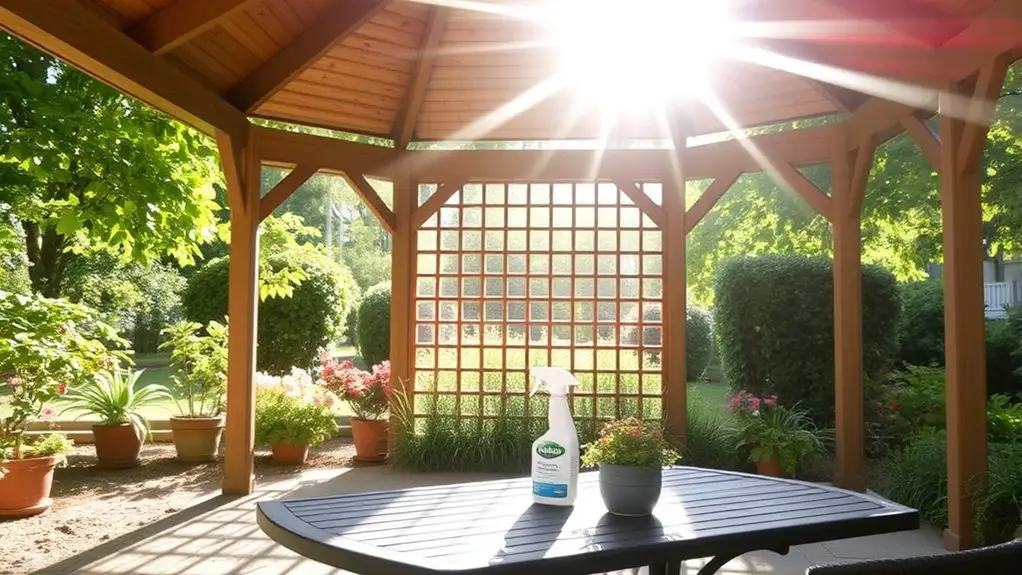To prevent mold and mildew in your gazebo, focus on controlling moisture and ensuring proper ventilation. Choose a location that gets ample sunlight and avoids low spots. Regularly clean the structure to remove organic debris and inspect for leaks. Use protective coatings that are water-resistant and mold-resistant. Enhance airflow with open windows and effective ventilation systems. By following these practices, you can greatly reduce the risk of mold growth, and more tips await you ahead.
Understanding the Causes of Mold and Mildew
While you might enjoy spending time in your gazebo, it’s essential to understand the conditions that foster mold and mildew growth. Various mold types thrive in damp, poorly ventilated areas, making your gazebo a potential breeding ground if conditions aren’t managed. High humidity, stagnant air, and organic materials like wood or fabric can contribute to this problem. To combat these issues, prioritize mildew prevention by ensuring proper ventilation and reducing moisture accumulation. Regularly inspect your gazebo for leaks and clean surfaces to eliminate organic debris. Using mold-resistant coatings can also help protect your gazebo from these unwanted guests. By understanding these factors, you can enjoy your outdoor space without the fear of mold and mildew taking over. Additionally, regular cleaning of your gazebo is crucial in preventing mold growth and maintaining a safe environment for you and your family.
Choosing the Right Location for Your Gazebo
Selecting the right location for your gazebo plays a significant role in preventing mold and mildew issues. To guarantee a healthy environment, consider the following factors:
- Sunlight Exposure: Choose a site that receives ample sunlight. Sunlight helps dry out moisture, reducing mold growth.
- Drainage Considerations: Avoid placing your gazebo in low spots where water can collect. Good drainage is vital to prevent dampness.
- Proximity to Trees: Position your gazebo away from overhanging branches. Leaves and debris can trap moisture and promote mold.
- Wind Direction: Consider prevailing winds. A well-ventilated area helps keep the gazebo dry by promoting airflow. Additionally, placing the gazebo in a location with adequate space around it can help ensure proper airflow and reduce dampness.
Regular Cleaning and Maintenance Practices
Regular cleaning and maintenance are essential to keep your gazebo mold- and mildew-free. Establishing regular cleaning schedules can greatly reduce the risk of mold growth. Aim to clean your gazebo at least once every season, focusing on removing dirt, debris, and organic matter. Use a mild detergent and a soft brush to avoid damaging the surface.
Incorporate maintenance tips like inspecting for leaks and repairing any damage promptly. Pay special attention to areas prone to moisture accumulation, such as corners and under furniture. Guarantee proper drainage around your gazebo to minimize water pooling. By adhering to these practices, you’ll maintain a clean and inviting space, allowing you to enjoy the freedom of your outdoor haven without the worry of mold or mildew. Additionally, regular inspections for damages can help identify potential moisture issues before they escalate.
Utilizing Protective Coatings and Sealants
To effectively prevent mold and mildew in your gazebo, utilizing protective coatings and sealants is vital. These protective products create a barrier against moisture, which is essential for maintaining a healthy space. Here are some application techniques to take into account:
- Choose the Right Sealant: Look for water-resistant and mold-resistant options.
- Prepare the Surface: Clean and dry the gazebo thoroughly before application to guarantee adhesion.
- Apply Evenly: Use brushes or sprayers to distribute the sealant uniformly, avoiding thick layers.
- Reapply Regularly: Follow the manufacturer’s recommendations for reapplication to maintain protection. Additionally, regular maintenance can restore water-resistant properties to further enhance the effectiveness of your protective measures.
Implementing Proper Ventilation and Airflow Techniques
Although it may seem simple, implementing proper ventilation and airflow techniques is essential for preventing mold and mildew in your gazebo. Start by evaluating your space and installing effective ventilation systems. This might include vents, windows, or even exhaust fans designed to promote airflow.
Next, consider airflow strategies that encourage cross-ventilation, allowing fresh air to circulate freely while pushing out stale air. Position furniture strategically to avoid obstructing air pathways, and keep doors and windows open whenever possible.
Regularly check for any blockages in vents and clean them to maintain ideal airflow. By focusing on these techniques, you’ll create a healthier environment that minimizes moisture buildup, ultimately protecting your gazebo from unwanted mold and mildew growth. Additionally, adequate shade provided by your gazebo can help reduce humidity levels, contributing to a less favorable environment for mold growth.
Frequently Asked Questions
What Materials Are Most Resistant to Mold and Mildew in Gazebos?
When choosing materials, consider wood finishes treated with anti-fungal agents and outdoor fabrics designed to resist moisture. These options provide durability and protection against mold and mildew, allowing you to enjoy your space worry-free.
How Often Should I Inspect My Gazebo for Mold and Mildew?
You wouldn’t want any unwelcome guests, right? For ideal gazebo maintenance, inspect it every few months. Regular inspection frequency helps catch potential mold and mildew issues early, ensuring your outdoor retreat stays inviting and enjoyable.
Can Indoor Mold Treatments Be Used Outdoors?
Indoor mold treatments aren’t designed for outdoor use. For effective outdoor mold treatments, choose products specifically formulated for exterior applications. Combining outdoor treatments with indoor mold prevention strategies guarantees thorough protection against mold and mildew growth.
What Are the Symptoms of Mold Exposure?
When exposed to mold, you might experience symptoms like coughing, sneezing, and skin irritation. These health effects can vary, so it’s essential to monitor your reactions and consult a professional if symptoms persist.
Are There Specific Plants That Attract Mold to Gazebos?
Certain plants can promote moisture, leading to mold growth. To combat this, consider incorporating mold-resistant plants into your landscape design. Regular gazebo maintenance is essential to minimize dampness and discourage mold attraction effectively.

